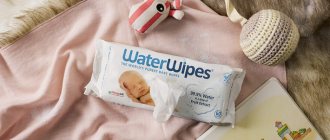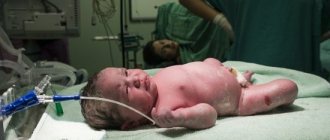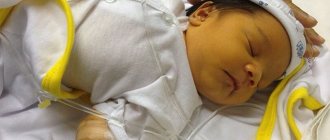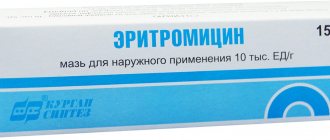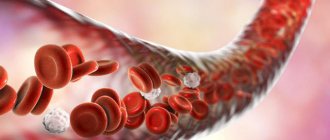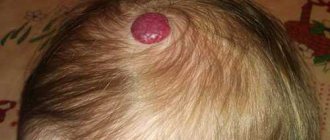For a baby in the womb, the umbilical cord is the only thread connecting him to the outside world. It is through it that food and oxygen enter his body. Immediately after birth, the need for such a link connecting the child with the mother’s body disappears, and the doctor cuts the umbilical cord, and over time a characteristic scar forms on the baby’s tummy. However, until the resulting wound has healed, it requires special care, so it is important to know how to treat a newborn’s navel to avoid problems.
How and when is the umbilical cord cut in a newborn?
This simple procedure begins by placing clamps on the umbilical cord in two places. The doctor then crosses the umbilical cord between them. It is very important to choose the right time to cut the umbilical cord, since if you do it too quickly, when its pulsation has not yet stopped, then oxygen-rich blood will not have time to return to the newborn’s circulatory system from the placenta, and then his hemoglobin and iron levels will decrease. After cutting the umbilical cord, a small fragment of the umbilical cord (stump) remains on the baby’s tummy, which disappears on its own after 3-10 days. Most often this happens on the 4-5th day after the baby is born. At first, a special liquid oozes from the unhealed navel - ichor, but this goes away over time (after about 3 weeks) and the navel heals.
How to treat a newborn's navel?
In the first days of life, the baby requires special care. Fortunately, even first-time mothers very quickly become real professionals in this complex matter and confidently carry out all the necessary procedures. They are usually shown how to treat a newborn’s navel in the maternity hospital. If a pregnant woman wants to learn about all the intricacies of this procedure before giving birth, then she should carefully read the following tips:
- The newborn's navel is treated daily until complete healing, and this is done after bathing.
- To properly treat the navel, young parents need to acquire hydrogen peroxide, cotton swabs, disinfectant (brilliant) and a pipette.
- Each time after bathing the baby, using a sterilized pipette, drop hydrogen peroxide onto the umbilical wound and wait about a minute until the liquid stops foaming. After that, softened yellow or bloody crusts are carefully removed with a cotton swab.
- When treating the navel daily, you should try to remove all the crusts, even if they are in hard-to-reach places, since bacteria can multiply under them.
- At the end of each procedure, the umbilical wound should be lubricated with brilliant green.
When peroxide dropped into the newborn's navel stops foaming, daily treatment procedures can be stopped. If a newborn’s navel does not heal even after the baby is one month old, then you should consult a pediatrician and think about more serious treatment.
How to treat a wound
The pediatrician gives parents recommendations on how to care for the baby upon discharge.
It is important to remember that treating the navel is a necessary condition for rapid healing. The procedure is performed under highly sterile conditions. There is no need to do this with your fingers or cotton wool.
To treat a wet navel, you need to prepare in advance:

- cotton buds;
- pipette;
- Chlorophyllipt (solution);
- Hydrogen peroxide.
First of all, you need to wash your hands well with soap. Next, the wound is examined and it is determined whether there is pus and an unpleasant odor.
A few drops of hydrogen peroxide are dripped onto the wound (it is not recommended to fill the hole). The drug should be at room temperature. After drying, the excess is carefully removed with a cotton pad.
Chlorophyllipt is dripped onto the wound. After this, the baby is dressed. The navel should not be under a diaper so that the skin can breathe and not get wet.
Means for treating the navel
If the navel is festered, experts recommend using the following remedies:
- Zelenka. This is an effective antiseptic with rapid action. Its use is allowed only externally.
- Hydrogen peroxide. This is a medicine whose action is aimed at disinfecting and cleansing wounds located on the surface.
- Baneocin. The drug belongs to the group of antibacterial agents and has a combined effect.
- Chlorophyllipt. Used to disinfect wounds.
Parents should remember that it is necessary to treat the wound in the navel with extreme caution. If healing does not occur within a month, the child should be shown to a specialist.
Is it possible to bathe a newborn with an unhealed navel?
Hygiene procedures are extremely important for the health of the newborn. However, you can begin daily bathing only after the umbilical cord falls off. The baby is usually bathed for the first time by health workers in the maternity hospital. At the same time, they don’t even try to make sure that water doesn’t get into the wound, since this will only make the crust easier to remove. At the same time, certain rules must be followed. For example, today pediatricians no longer recommend bathing a newborn in water to which potassium permanganate has been added, since even such a very weak solution has a drying effect on the skin. However, the requirement to bathe a baby with an unhealed navel in pre-boiled and then cooled water remains in force.
Well, you already know how to treat a newborn’s navel.
What not to do?
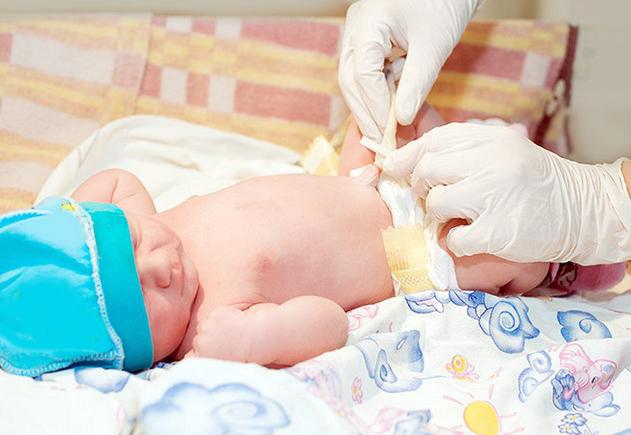
Today, pediatricians categorically do not recommend:
- cover the newborn's navel with a plaster, since he must breathe, otherwise bacteria will accumulate and multiply in it, causing infection;
- treat the umbilical wound more often than once a day, since the wound will heal the sooner the less you touch it;
- It is not recommended to use antiseptics other than hydrogen peroxide and brilliant green.
Why does a newborn's belly button bleed?
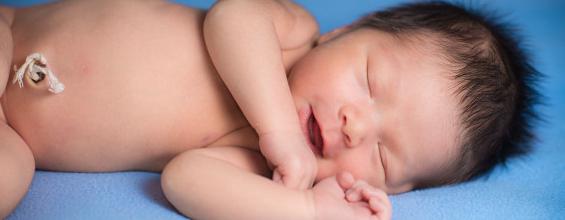
If the baby is properly cared for, his umbilical wound usually heals quickly, and no bleeding is observed. Among the most common reasons why a newborn's navel bleeds are the following:
- Features of the umbilical cord. In particular, if it was too thick, then when it dies, a deep wound may form, and healing will take several weeks.
- Lack of air baths. Sometimes a newborn's navel bleeds in the absence of proper air circulation, since in this case the umbilical wound heals poorly, and an infection may even develop.
- Inaccurate circumcision of the navel in the maternity hospital or rubbing the umbilical wound with a vest or diaper.
- Early placement of the baby on the stomach. In general, up to 3 weeks, it is better for the baby to sleep and lie only on its side or on its back.
As soon as the mother notices blood in the navel, she needs to take emergency measures and, first of all, go to the pediatrician. However, it is not recommended to bathe a baby with a bleeding navel. Instead, you just need to wipe its body with a wet sponge, trying not to touch the wound.
Why does the umbilical wound of a newborn bleed and become wet?
A sign of improper care is the appearance of bloody discharge. Bleeding or suppuration of the navel is a reason to consult a doctor.
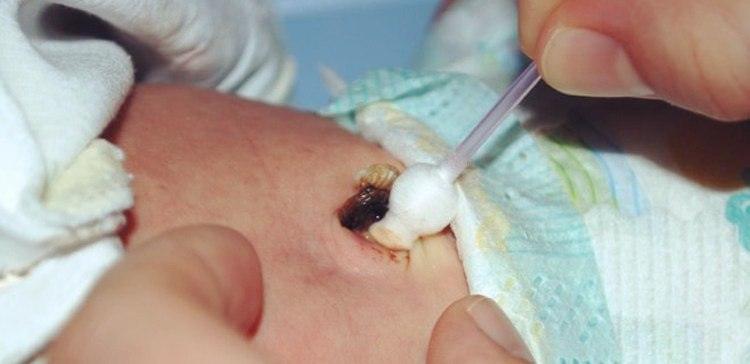
A newborn's wound gets wet and bleeds for several reasons:
- Thick umbilical cord. Due to its natural feature, such an umbilical cord forms a deep wound when it dries. Healing may take longer than usual.
- Fogging. In order for the umbilical wound to heal faster, it needs air. A newborn baby needs air baths. You shouldn’t immediately wrap him in diapers after changing the diaper, but give him the opportunity to be naked for a few minutes. Oxygen circulation will help the wound heal faster and strengthen the baby.
- Injury to the navel by the edge of the diaper, rubbing and squeezing by clothing. You should choose a diaper with a notch for the umbilical cord or wear it over a clean, ironed vest. The wound should not come into contact with wet fabric.
- Acquired infection. Diaper dermatitis, handling the navel with dirty hands, and lack of hygiene procedures after a newborn defecates often cause infection of the wound.
- Infection during childbirth , causing an inflammatory process. It can occur due to unskilled cutting of the umbilical canal with non-compliance with hygiene rules.
If you do not consult a doctor in a timely manner and do not take action, serious complications may occur. One of them is omphalitis. When the umbilical wound does not heal for a long time, it continues to leak and ooze, the skin around it turns red, and pus is released from the wound itself, which means that an infection has penetrated into it and inflammation has begun. For omphalitis, characterized by a weeping navel, slight swelling of the umbilical cord ring, the wound is treated 4 times a day. Furacilin, Dioxidin or Chlorophyllipt are dripped into the navel, cleaned of crust and peroxide. The baby is temporarily not bathed.
If the doctor diagnoses necrotic, phlegmonous or purulent omphalitis, you will have to deal with the pathology in the hospital. You will need to take antibiotics, apply bandages with antiseptic ointments, and cauterize the fungus. Doctors at the hospital will tell you how to treat a navel with a pathological process.
What to do if your baby's belly button is festered?
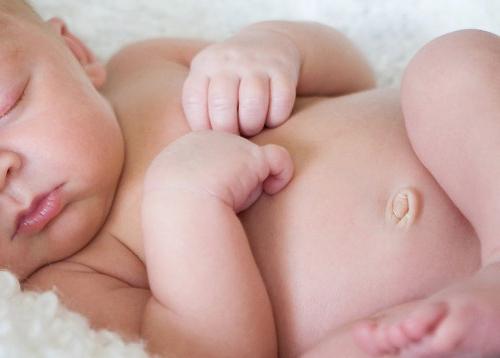
For the health of the baby in the first days of life, compliance with all hygiene standards and good care is of particular importance. Unfortunately, although information on how to properly treat a newborn’s navel is available to everyone, sometimes the wound can fester. This phenomenon has its own name - omphalitis, and its cause is streptococci, staphylococci, as well as Pseudomonas aeruginosa or Escherichia coli. At the initial stage of the disease, babies become nervous, often cry, lose their appetite and sleep poorly. Then their skin around the navel turns red and discharge appears, which, when dried, sometimes even forms purulent crusts. As a result, a so-called wet navel is formed.
Time in the hospital
The umbilical cord is an amazing cord created by nature for the exchange of food, its processed products, immunity, psychological state, emotions and thoughts of mother and baby.
From the moment of birth, after a few minutes, it is cut off, and the baby’s independent life begins.
A plastic clothespin and about 3 cm of umbilical cord residue remain above the navel, which will gradually dry out and become mummified.
While a young mother is recovering from childbirth, she does not think about how to treat the newborn’s navel and what to do if his umbilical wound gets wet or bleeds. While she is watching all the actions from the side. And treating a child’s umbilical wound is the responsibility of nurses.
On average, the baby's umbilical remnant falls off on its own after 4-5 days . However, many maternity hospitals nowadays practice surgical cutting off with scissors or a blade just before discharge. In this case, the umbilical wound is covered with a special plaster for a couple of hours to stop the bleeding. Then it is removed and the navel is cared for as usual until it is completely healed.
In the maternity hospital, both the umbilical cord and the umbilical wound are cared for once a day, if the latter does not get wet. If the baby's umbilical ring is wide, after the appearance of a hemorrhagic crust, discharge in the form of droplets of ichor or blood is possible. Usually the doctor in these cases prescribes more frequent hygiene procedures. Sometimes the fact that the wound gets wet is simply a sign of high ambient temperatures.
What to do if your baby's belly button gets wet?
At the first suspicion of omphalitis in a child, you should contact a pediatrician. After all, if a newborn’s navel gets wet, and this problem is not properly addressed, then acute purulent inflammation (phlegmon) often develops, which can even lead to tissue necrosis or peritonitis. If the process has just begun, then the baby is prescribed daily abundant washing of the umbilical wound with a 3% solution of hydrogen peroxide or a 0.02% solution of furatsilin. After washing, the navel is dried with a sterile bandage and lubricated with brilliant green using a cotton swab.

At the same time, some pediatricians recommend replacing brilliant green with 70% alcohol or a 5% solution of potassium permanganate, since when lubricating the wound with brilliant green, redness may not be noticeable. If the condition of the navel does not improve, the doctor may prescribe antibiotics for the baby, administer gamma globulin, or prescribe other measures. In any case, if you notice that your newborn’s navel is getting wet or bleeding, you should not treat it yourself to prevent omphalitis.
For what reasons can the navel fester?
As the umbilical wound heals, fluid may ooze. This leads to the formation of crusts along the edges of the navel . They must be carefully removed, but not torn off, but soaked, to prevent infection.

Among the many factors that can provoke purulent discharge, experts note a weakening of the infant’s immune system.
When the body's defenses are reduced, the body cannot resist pathogenic bacteria, resulting in suppuration. This may cause the development of a more serious disease caused by Staphylococcus aureus.
If you follow hygiene procedures and monitor the healing of the wound, then parents should not worry. A condition in which the navel becomes wet in the first month of life is normal. The umbilical cord heals and all symptoms go away.
Pediatricians identify two reasons that can lead to the appearance of purulent discharge from the umbilical wound:
- poor care of the baby with violation of hygiene standards;
- penetration of pathogenic microbes into the wound.
There are several pathological conditions that can provoke the release of purulent contents from the navel.
Fistula
In appearance, the formation resembles purulent omphalitis. This is a small hole in the navel wound. It connects to the bladder or intestines. From it, the contents of the internal organs begin to ooze into the umbilical ring.
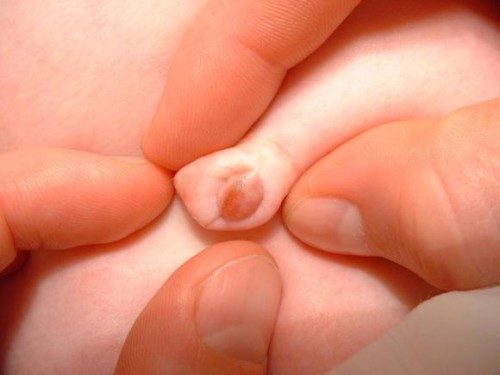
This condition prevents the skin from healing and leads to inflammation. If there is a suspicion that a child has developed a fistula, you should immediately seek medical help, since its treatment is carried out only by surgical methods.
Omphalitis
This is a pathological process characterized by inflammation of the skin around the navel. In this condition, there is pronounced swelling and an unpleasant odor. Pus comes from the navel and fluid oozes .
The discharge varies in shades from light to brown with some bloody inclusions.



